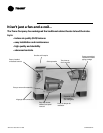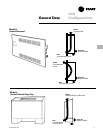
Features and
Benefits
CAB-PRC001-EN4
The Force–Flo™ cabinet heater meets the
standards of today’s market, as well as
the anticipated needs of tomorrow’s
market. The tradition that company
founder Reuben Trane began in 1913
continues with the latest generation of
cabinet heaters from Trane.
The Force–Flo cabinet heater is the leader
in these key areas:
• Indoor Air Quality (IAQ)
• Controls
• Flexibility
• Quality
• Serviceability
Today’s HVAC market is concerned with
issues such as indoor air quality (IAQ)
and CFCs that demand a change in HVAC
products. In addition, renovation has
overtaken new construction in the
cabinet heater market—demanding a
design that caters to renovation issues.
Trane is concerned with these issues,
too. That’s why we designed the Force–
Flo cabinet heater as an integral part of
the company’s system solutions with
standard IAQ-related features that fully
comply with ASHRAE 62.
IAQ Design
• Closed-cell insulation is standard on all
units to help prevent fiberglass in the
airstream.
• Easy filter access encourages frequent
changing.
• Force–flo cabinet heaters have a blow-
thru design.
Controls
• All controls are factory-mounted and
tested to minimize field setup.
• Controls are wired with a 24 VAC
transformer to keep only a single
source power connection requirement
to the unit.
• All wall-mounted zone sensors require
only low voltage control wiring from
the device to the unit control box. (No
line voltage.)
• The Tracer
®
controls family introduces
the latest in control technology with the
ZN.010, ZN.510, and ZN.520 controllers.
• The random start-up feature helps
reduce electrical demand peaks by
randomly staggering multiple units at
start-up.
• Occupied/unoccupied operation allows
the controller to utilize unoccupied
temperature setpoints for energy
savings.
• Warm-up energy feature is standard
with Trane controls.
• Continuous fan or fan cycling is avail-
able with ZN.010 or ZN.510.
• Monitor unit operation using Tracer
®
Summit building management system
with ZN.510 or ZN.520.
• To customize unit control, Tracer
Summit or Rover
™
software will allow
field modification of ZN.510 and ZN.520
default settings. For ZN.010, use Rover
to field modify default settings.
• Maximize cabinet heater system
efficiency with modulating valves on
units with ZN.520.
Flexibility
• Two, three, and four-row hot water coils
allow greater design flexibility. Steam
distributing or electric heat coils are
also available.
• Fan motors are available for either high
static (0.4-inch external static pressure)
or free discharge applications.
• Piping is factory assembled, mounted
and tested. Units are also available
without piping.
• Factory piping options include intercon-
necting piping, control valves, and end
valves. Deluxe piping also has unions
and a strainer.
• Control options range from a simple fan
speed switch to a DDC controller that
can tie into a Tracer Summit
®
building
automation system.
• The extended end pocket option adds 8-
inches (20 cm) to the piping end of
cabinet style units.
• Slope-top vertical cabinet units are an
excellent application for school and
dormitories to prevent items from
being placed on top of the units.
• Vertical wall hung units are used in
vestibules, bathrooms, stairwells, or
other applications when the unit cannot
be installed on the floor
• Inverted unit models allow heating to
circulate from the bottom of the unit.
Quality
• Coils and piping packages are air and
leak-tested before mounting on the
unit.
• Coil piping connections are also air and
leak-tested after mounting on the unit.
• All control end devices and moving
components (fans and motors) are
computer-tested after units are
complete.
Serviceability
• Filters are easily removable and
changed without removing the front
panel on vertical cabinet units.
• Motors are easy to disconnect from the
fan board, allowing easy service.
• The manual output test function is an
invaluable troubleshooting tool. By
simply pressing the test button on the
Tracer
®
ZN.510, ZN.520, or ZN.010;
service personnel can manually
exercise outputs in a pre-defined
sequence.


















